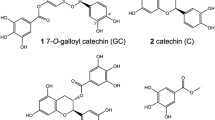Summary
In the present investigation the antiproliferative activity of thirteen derivatives of betulinic acid and betulin was tested against five different tumor cell lines. The toxicity against normal human fibroblasts (WWO70327) and the mode of cell death on HT-29 (colon cancer) as well as caspase activity induced by the most active compounds, 9 (3-O-chloroacetylbetulinic acid) and 15 (28-O-chloroacetylbetulin) were determined. Investigated derivatives exerted a dose dependent antiproliferative action at micromolar concentrations toward target tumor cell lines. Treatment of HT-29 cells for 24 h with 9 and 15 induced apoptosis, as observed by dye exclusion test (trypan blue) and confirmed by the appearance of a typical ladder pattern in the DNA fragmentation assay.




Similar content being viewed by others
References
Fulda S, Jeremias I, Steiner HH, Pietsch T (1999) Debatin KM (1999) Betulinic acid: a new cytotoxic agent against malignant brain-tumor cells. Int J Cancer 82:435–441
Schmidt ML, Kuzmanoff KL, Ling-Indeck L, Pezzuto JM (1997) Betulinic acid induces apoptosis in human neuroblastoma cell lines. Eur J Cancer 33:2007–2010
Zuco V, Supino R, Righetti SC, Cleris K, Marchesi E, Gambacorti-Passerini C, Formelli F (2002) Selective cytotoxicity of betulinic acid on tumor cell lines, but not normal cells. Cancer Lett 175:17–25
Pisha E, Chai H, Lee IS, Chagwedera TE, Farnsworth NR, Cordell AC, Beecher CWW, Fong HHS, Kinghorn AD, Brown DM, Wani MC, Wall ME, Hieken TJ, Das Gupta TK, Pezzuto JM (1995) Discovery of betulinic acid as a selective inhibitor of human melanoma that functions by induction of apoptosis. Nat Med 1:1046–1051
Fulda S, Friesen C, Los M, Scaffidi C, Mier W, Benedict M, Nunez G, Krammer PH, Peter ME, Debatin KM (1997) Betulinic acid triggers CD95 (APO-1/Fas)- and p53-independent apoptosis via activation of caspases in neuroectodermal tumors. Cancer Res 57:4956–4964
Fulda S, Scaffidi C, Susin SA, Krammer PH, Kroemer G, Peter ME, Debatin KM (1998) Activation of mitochondria and release of mitochondrial apoptogenic factors by betulinic acid. J Biol Chem 273:33942–33948
Fulda S, Debatin KM (2000) Betulinic acid induces apoptosis through a direct effect on mitochondria in neuroectodermal tumors. Med Pediatr Oncol 35:616–618
Melzig MF, Bormann H (1998) Betulinic acid inhibits aminopeptidase N activity. Planta Med 64:655–657
Kwon HJ, Shim JS, Kim JH, ChoHY YumYN, Kim SH, Yu J (2002) Betulinic acid inhibits growth factor-induced in vitro angiogenesis via the modulation of mitochondrial function in endothelial cells. Jpn J Cancer Res 93:417–425
Salti GI, Kichina JV, Das Gupta TK, Uddin S, Bratescu L, Pezzuto JM, Mehta RG, Constantinou AI (2001) Betulinic acid reduces ultraviolet-C-induced DNA breakage in congenital melanocyte naeval cells:Evidence for a potential role as a chemopreventive agent. Melanoma Res 11:99–104
Syrovets T, Buchele B, Gedig E, Slupsky JR, Simmet T (2000) Acetyl-boswellic acids are novel catalytic inhibitors of human topoisomerase I and IIa. Mol Pharm 58:71–81
Yasukawa K, Takido M, Matsumoto T, Takeuchi M, Nakagawa S (1991) Sterol and triterpene derivatives from plants inhibit the effects of a tumor promoter, and sitosterol and betulinic acid inhibit tumor promotion in mouse skin two-stage carcinogenesis. Oncology 48:72–76
Yasukawa K, Yu SY, Yamanouchi S, Takido M, Akihisa T, Tamura T (1995) Some lupane-type triterpenes inhibit tumor promotion by 12-O-tetradecanoylphorbol-13-acetate in two-stage carcinogenesis in mouse skin. Phytomedicine 4:309–313
Bringmann G, Saeb W, Assi LA, Francois G, Narayanan ASS, Peters K, Peters EM (1997) Betulinic acid: Isolation from Triphyophyllum peltatum and Ancistrocladus heyneanus, antimalarial acitivity, and crystal structure of the benzyl ester. Planta Med 63:255–257
Steele JCP, Warhurst DC, Kirby GC, Simmonds MSJ (1999) In vitro and in vivo evaluation of betulinic acid as an antimalarial. Phytother Res 13:115–119
Recio MC, Giner RM, Manez S, Gueho J, Julien HR, Hostettmann K, Rios JL (1995) Investigations on the steroidal anti-inflammatory activity of triterpenoids from Diospyros leucomelas. Planta Med 61:9–12
Huguet A-I, Recio MC, Manez S, Giner RM, Rios JL (2000) Effect of triterpenoids on the inflammation induced by protein kinaseCactivators, neuronally acting irritants and other agents. Eur J Pharmacol 410:69–81
Fujioka T, Kashiwada Y, Kilkuskie RE, Cosentino LM, Ballas LM, Jiang JB, Janzen WP, Chen I-S, Lee KH (1994) Anti-AIDS agents. 11. Betulinic acid and platanic acid as anti-HIV principles from Syzigium claviflorum, and the anti-HIV activity of structurally related triterpenes. J Nat Prod 57:243–247
Kommera H, Kaluđerović GN, Kalbitz J, Paschke R (2009) Microwave mediated synthesis and structure-activity relationships of betulin and betulinic acid derivatives. Bioorg Med Chem submitted
Skehan P, Storeng R, Scudiero D, Monks A, McMahon J, Vistica D, Warren JT, Bokesch H, Kenney S, Boyd MR (1990) New colorimetric cytotoxicity assay for anticancer-drug screening. J. Natl. Cancer Inst 82(13):1107–1112
Dietrich A, Mueller T, Paschke R, Kalinowski B, Behlendorf T, Reipsch F, Fruehauf A, Schmoll HJ, Kloft C, Voigt W (2008) 2-(4-(tetrahydro-2H-pyran-2-yloxy)-undecyl)-propane-1, 3-diamminedichloroplatinum(II): ANovel Platinum Compound that Overcomes Cisplatin Resistance and Induces Apoptosis by Mechanisms Different from that of Cisplatin. J Med Chem 51:5413–5422
Acknowledgement
The authors are grateful to the Wirtschaftsministerium Sachsen-Anhalt for financial support (Antitumor drugs on the basis of natural compounds FuE 62/05).
Author information
Authors and Affiliations
Corresponding author
Rights and permissions
About this article
Cite this article
Kommera, H., Kaluđerović, G.N., Kalbitz, J. et al. Lupane Triterpenoids—Betulin and Betulinic acid derivatives induce apoptosis in tumor cells. Invest New Drugs 29, 266–272 (2011). https://doi.org/10.1007/s10637-009-9358-x
Received:
Accepted:
Published:
Issue Date:
DOI: https://doi.org/10.1007/s10637-009-9358-x



